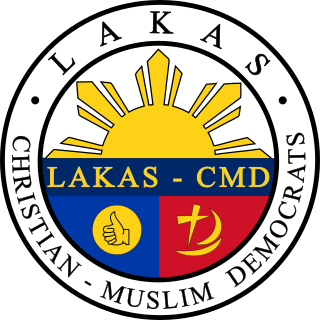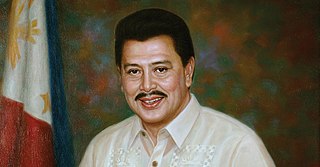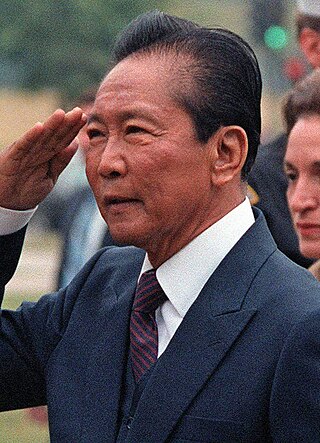
Lakas–Christian Muslim Democrats, abbreviated as Lakas–CMD and popularly known as Lakas, was a political party in the Philippines. Its ideology and that of its successor is heavily influenced by Christian and Islamic democracy. The party's influence on Philippine society is very strong, especially after the People Power Revolution, which has led the country to elect two presidents from the party, namely Fidel V. Ramos, a United Methodist, and Gloria Macapagal Arroyo, a Roman Catholic.

The Pwersa ng Masang Pilipino, formerly Partido ng Masang Pilipino, is a populist political party in the Philippines. It is the political party of former Philippine President Joseph E. Estrada. In the May 1998 presidential election, it aligned itself with other political parties to form the Laban ng Makabayang Masang Pilipino.

The Laban ng Makabayang Masang Pilipino was the umbrella political coalition opposition party during the 1998 Philippine general election that led to the election into the presidency of then-Vice President Joseph Estrada. It was the largest political party during that time, uniting the major Philippine political parties which included then Senator Edgardo Angara's Laban ng Demokratikong Pilipino, business tycoon Danding Cojuangco's Nationalist People's Coalition and Estrada's Partido ng Masang Pilipino, along with minor and regional parties. Angara, the running mate of Estrada, lost to fellow senator Gloria Macapagal Arroyo of Lakas—NUCD—UMDP. Estrada won the presidency against then-House Speaker Jose de Venecia Jr. with a plurality margin of six million votes.

The 1998 election of members to the Senate of the Philippines was the 26th election to the Senate of the Philippines. It was held on Monday, May 11, 1998 to elect 12 of the 24 seats in the Senate. The two main competing coalitions in the senatorial election were Lakas—National Union of Christian Democrats—United Muslim Democrats of the Philippines and the Laban ng Makabayang Masang Pilipino umbrella coalition composed of Laban ng Demokratikong Pilipino, Pwersa ng Masang Pilipino, Nationalist People's Coalition, and Partido Demokratiko Pilipino—Lakas ng Bayan. The two coalitions split the 12 contested seats 7–5 in favor of LAMMP.

The 1992 election of members to the Senate of the Philippines was the 24th election to the Senate of the Philippines. It was held on Monday, May 11, 1992. This was the first general election under the 1987 Philippine Constitution. An estimated 80,000 candidates ran for 17,000 posts, from the presidency all the way down to municipal councilors.

The 1998 Philippine presidential and vice presidential elections were held on May 11, 1998. In the presidential election, Vice President Joseph Estrada won a six-year term as President by a landslide victory. In the vice-presidential race, Senator Gloria Macapagal Arroyo won a six-year term as Vice President, also by a landslide victory. This was the third election where both the president and vice president came from different parties.

A parliamentary election was held in the Philippines on April 7, 1978, for the election of the 165 regional representatives to the Interim Batasang Pambansa. The elections were participated in by the leading opposition party, the Lakas ng Bayan (LABAN), which had twenty-one candidates for the Metro Manila area while the leading candidate was the jailed opposition leader Ninoy Aquino, and the Marcos regime's party known as the Kilusang Bagong Lipunan (KBL), which was led by the then-First Lady Imelda Marcos. Ninoy was allowed to run by his fellow partymates under the Liberal Party, who boycotted the election and was not allowed to campaign, and so his family campaigned for him. The night before the election on April 6, 1978, a noise barrage was organized by the supporters of (LABAN) which occurred up to dawn.

The 11th Congress of the Philippines, composed of the Philippine Senate and House of Representatives, met from July 27, 1998, until June 8, 2001, during the 31-month presidency of Joseph Estrada and the first four months of Gloria Macapagal Arroyo's presidency. The convening of the 11th Congress followed the 1998 national elections, which replaced half of the Senate membership, and the entire membership of the House of Representatives. The Estrada impeachment was the highlight of the 11th Congress.

Presidential and vice presidential elections, legislative elections and local elections were held in the Philippines on May 11, 1992. An estimated 80,000 candidates ran for 17,000 posts from the presidency down to municipal councillors in the first general election under the 1987 Constitution. Even though she was permitted by the Constitution to run for a second term, President Corazon Aquino did not stand for re-election.
Elections for the House of Representatives of the Philippines were held on November 10, 1953. Held on the same day as the presidential election, the party of the incumbent president, Elpidio Quirino's Liberal Party, won majority of the seats in the House of Representatives. However, Ramon Magsaysay of the opposition Nacionalista Party was elected president, and several elected Liberal Party congressmen defected to the Nacionalista Party, leading to José Laurel, Jr. being elected Speaker of the House of Representatives.
Elections for the House of Representatives of the Philippines were held on November 14, 1961. Held on the same day as the presidential election, the party of the incumbent president, Carlos P. Garcia's Nacionalista Party, won majority of the seats in the House of Representatives. However, Diosdado Macapagal of the opposition Liberal Party won the presidential election, leading to majority of the elected Nacionalista congressmen to defect to the Liberal Party. This led to Cornelio Villareal being elected Speaker of the House of Representatives.
Elections for the House of Representatives of the Philippines were held on November 9, 1965. Held on the same day as the presidential election, the party of the incumbent president, Diosdado Macapagal's Liberal Party, won a majority of the seats in the House of Representatives. Despite Ferdinand Marcos of the opposition Nacionalista Party winning the presidential election, Liberal Party congressmen did not defect to the Nacionalista Party. This led to Cornelio Villareal being retained Speaker of the House after retaking it from Daniel Romualdez midway during the previous Congress.
Elections for the House of Representatives in the Philippines were held on May 11, 1987. This was the first legislative election since 1984, the first House of Representatives elections since 1969, and the first election since the People Power Revolution that overthrew president Ferdinand Marcos and brought Corazon Aquino to power after alleged election fraud by the former during the 1986 presidential election against the latter.
Elections for the House of Representatives of the Philippines were held on May 11, 1992. Held on the same day as the presidential election since incumbent president Corazon Aquino did not contest the election, the Laban ng Demokratikong Pilipino (LDP) served as the de facto administration party; just as all House of Representative elections, the perceived party of the president won majority of the seats in the House of Representatives. However, Fidel V. Ramos of Lakas-NUCD won the presidential election; this caused most of the newly elected congressmen to abandon the LDP for Lakas-NUCD.
Elections for the House of Representatives of the Philippines were held on May 8, 1995. Being the first midterm election since 1938, the party of the incumbent president, Fidel V. Ramos's Lakas-NUCD-UMDP, won a plurality of the seats in the House of Representatives.

Elections for the House of Representatives of the Philippines were held on May 14, 2001. This was the next election succeeding the events of the 2001 EDSA Revolution that deposed Joseph Estrada from the presidency; his vice president, Gloria Macapagal Arroyo became president, and her party, Lakas NUCD-UMDP, and by extension the People Power Coalition (PPC), dominated the midterm elections winning majority of the seats in the Senate and in the House of Representatives.

Elections for the House of Representatives of the Philippines were held on May 10, 2004. Being held together with presidential election, the party of the incumbent president Gloria Macapagal Arroyo, Lakas-Christian Muslim Democrats, and by extension the administration-led coalition, the Koalisyon ng Katapatan at Karanasan sa Kinabukasan (K4), won majority of the seats in the House of Representatives.

The Kabalikat ng Malayang Pilipino (KAMPI), formerly known as the Kabalikat ng Mamamayang Pilipino, was a political party in the Philippines. It is the main party of former President Gloria Macapagal Arroyo. In June 2008, Kampi merged into the Lakas–CMD.

The Laban ng Demokratikong Pilipino is a liberal political party in the Philippines.













